Frick exhibits major gift of decorative arts and pastels
NEW YORK, NY.- The celebrated holdings of decorative arts objects amassed by Henry Clay Frick have been significantly enriched in recent decades by gifts from other collectors. In 1999, Winthrop Kellogg Edey’s bequest added to the museum’s holdings an important group of European clocks and watches, and in the last decade or so, gifts from Dianne Dwyer Modestini (2008), Melinda and Paul Sullivan (2016), Henry Arnhold (2019), and Sidney R. Knafel (2021) have reshaped the Frick’s holdings of European ceramics with significant groups of Du Paquier and Meissen porcelain, French faience, and Italian maiolica. A remarkable bequest in 2020 from the collection of Alexis Gregory builds on this tradition by enhancing the museum’s existing holdings and introducing to the museum new types of objects. Beginning in February 2023, visitors can enjoy a special exhibition of these works, shown by the Frick for the first time together. The Gregory Gift (February 16 through July 9, 2023) features the twenty-eight acquisitions in a variety of media and forms, curious luxury objects that, shown together, suggest a fine collector's cabinet or Kunstkammer. Among them are fifteen Limoges enamels, two clocks, two ewers, a gilt-bronze sculpture, a serpentine tankard, an ivory hilt, a rhinoceros horn cup, a pomander, and two stunning pastels by Rosalba Carriera. The exhibition is organized by Marie-Laure Buku Pongo, Assistant Curator of Decorative Arts, and will be accompanied by a catalogue and complementary education programs.
Comments Ian Wardropper, Anna-Maria and Stephen Kellen Director of the Frick, “Alexis Gregory had one of the finest collections of Renaissance and Rococo decorative arts in this country. His deep affection for the Frick led to his bequest of a selection of a superb group of objects, and we are gratified to mount this exhibition in his memory.” Buku Pongo adds, “This generous and important gift to The Frick Collection opens new areas of research and lays the groundwork for exciting projects. From research into the context of their creation to technical analyses expanding our knowledge of how these objects were produced, the exhibition at Frick Madison will celebrate Alexis Gregory’s generous gift and The Frick Collection’s commitment to the display of European decorative arts.”
Gregory built his career in book publishing, establishing the celebrated Vendome Press, a publisher of significant volumes on French culture and art. His contributions to and engagement in the arts included serving on art committees at several cultural institutions in the United States, including the visiting committees of European Paintings and European Sculpture and Decorative Arts at the Metropolitan Museum of Art. His history with the Frick began with frequent visits to the museum as a youth. On one occasion, Gregory left the boarding school he was attending with a classmate to visit the museum and managed to convince his friend that he lived in its mansion, as everyone they encountered on staff seemed to know him extremely well. At Harvard, he studied with leading art historians. Those close to him often described him as a Renaissance man, as he spoke several languages, wrote books, traveled the globe, and collected art. These pursuits went hand in hand, as collecting art allowed him to research objects and travel around Europe to find new acquisitions. The purchase of his first Renaissance bronze at the age of eighteen marked the starting point of his collection.
Gregory collected widely, from paintings and works on paper to bronzes and sculptures. In the 1980s, his deep interest in European decorative arts prompted him to exchange one of the Impressionist paintings he had inherited from his parents for an assortment of bronzes, sculptures, and Limoges enamels, as well as a watercolor. He later expanded his collection with additional sculptures, Italian bronzes, and Limoges enamels, continuing throughout his life to
acquire objects from the United States and Europe. Gregory’s collection echoes, in many ways, the Kunstkammers created by princes during the Renaissance, where they would not only display enamels, faience, carved ivories, automatons and clocks, and precious and mounted metalwork, but also show exotic natural specimens.
A Saint-Porchaire ceramic ewer joins two such objects already in The Frick Collection. This addition is particularly significant as only about seventy Saint-Porchaire works exist today. The ewer is part of a limited experimental production that still poses many questions and is represented in a few museums, among them, the Metropolitan Museum of Art, the Victoria and Albert Museum, and the Musée du Louvre.
Saint-Porchaire Ware. Ewer (Biberon), Mid-16th century. Lead-glazed earthenware, 10 1/4 × 5 1/16 × 5 1/16 in. (26 × 12.9 × 12.9 cm). The Frick Collection, Gift of Alexis Gregory, 2020. Photo Joseph Coscia Jr.
Part of a very small, luxurious production created during the reign of King Henry II of France (r. 1547–59), this three-handled ewer, or biberon (nursing bottle), has a complex molded, stamped, and inlaid decoration consisting of foliage, leaves, cabochons, and leonine masks. The delicate interlacing forms several intricate patterns, and a strapwork cartouche features a coat of arms made up of three fleurs-de-lys. Saint-Porchaire ware, most of which was destined for the royal family and important patrons, is named after a village in a French region rich in the white clay that is its main component.
Other highlights from the gift include a fine group of Limoges enamels, including a significant number of grisaille examples, which strengthens the Frick's holdings of mostly polychrome enamels. Grisaille refers to a technique developed in the sixteenth century that was often used by enamelers including the famed Pierre Reymond (1513–after 1584). The Gregory gift includes multiple enamels by Reymond and his workshop, as well as objects by Jean de Court (act. 1541–83) and broadens the representation of these artists at the Frick. A large dish enameled on copper with at his center a Saxon silver coin engraved by Hans Biener (ca. 1556–1604), is the first of its kind to enter the collection. It belongs to a rare production in sixteenth-century Venetian workshops, and only about three hundred pieces exist today. (Of these, only about fifty have painted coats of arms or coins, making this example quite rare.)
Pierre Reymond (1513–after 1584), Saltcellar, Limoges, ca. 1545. Enamel on copper, parcel-gilt. H. 2 13/16 (7.1 cm); diam. 4 3/4 in. (12.1 cm). Marks (underside): P.R. The Frick Collection, , Gift of Alexis Gregory, 2021. Photo Joseph Coscia Jr.
The body of this saltcellar depicts two scenes: Venus seated on a chariot drawn by four doves and four figures standing near a column. The first image derives from a Marcantonio Raimondi (ca. 1480–1534) engraving made after a design by Raphael that illustrates episodes from the first book of Virgil’s Aeneid. The second one may illustrate the episode in the same book in which Dido, the Queen of Carthage, receives Aeneas. On the neck is a French inscription painted in gold—1545 PRENE EN GRE (Accept this willingly)—which likely refers to a poem from the Cent Ballades (Hundred Ballads) written by Christine de Pisan (1364–ca. 1430). A male portrait in the antique style is in the receptacle.
Master I.C., probably Jean de Court (act. 1541–83) or Jean Court (act. 1553–85), Plaque: Jupiter under a Canopy, Limoges, 16th century. Enamel on copper, parcel-gilt, 4 3/16 × 3 3/8 in. (10.6 × 8.6 cm). Marks (above the figure of Jupiter): I.C. The Frick Collection, Gift of Alexis Gregory, 2021. Photo Joseph Coscia Jr.
Standing under a canopy in the center of this enameled plaque, Jupiter appears triumphant. He wears a crown and holds a scepter; the eagle, one of his attributes, is at his feet. Seated beside him are two figures—likely monks or scholars—portrayed with asses’ ears, a representation often used at the time to depict the corruption of the Catholic Church. The decorative elements include grotesques, flowers and leaves, birds and animals, and the head of a putto. The elaborate composition on the front derives from an engraving by Etienne Delaune (ca. 1518–1583) that is from a suite of grotesques with Roman divinities (Suite de grotesques avec des divinités). The back of the case contains a mirror.
Attributed to Jean de Court (act. 1541–83), also known as Master I.C. (act. ca. 1550–85) and probably Jean Court dit Vigier (act. ca. 1555–58), Plate: Jupiter on a Chariot, Limoges, mid-16th century. Enamel on copper, parcel-gilt. Diam. 9 in. (22.9 cm); d. 5/8 in. (1.6 cm). The Frick Collection, Gift of Alexis Gregory, 2021. Photo Joseph Coscia Jr.
The scenes on these plates may derive from a series of woodcuts illustrating planetary gods by Gabriele Giolito de’ Ferrara (ca. 1508–1578), published in 1534, or from The Seven Planets, a series of woodcuts by Georg Pencz (ca. 1500–1550). The first plate shows Jupiter seated on a chariot drawn by peacocks. He holds a thunderbolt and a scepter, two of his attributes. The composition is set against a dark sky highlighted with gold stars and clouds. Beneath the chariot is a coat of arms that has not been identified. The rim is decorated with heads of satyrs, grotesques, scrolls, and strapwork. The reverse has two masks with arabesques in gold and strapwork in grisaille. The second plate shows Saturn seated on a chariot drawn by two dragons. He holds a sickle in his right hand and a child’s foot in his left. The coat of arms beneath the chariot has not yet been identified. The rim has four masks, scrolls, and fruit garlands. The reverse has four masks, strapwork with laurels, and fruit garlands in grisaille and arabesque motifs.
Attributed to Jean de Court (act. 1541–83), also known as Master I.C. (act. ca. 1550–85) and probably Jean Court dit Vigier (act. ca. 1555–58), Plate: Saturn on a Chariot, Limoges, mid-16th century. Enamel on copper, parcel-gilt. Diam. 9 in. (22.9 cm); d. 5/8 in. (1.6 cm). The Frick Collection, Gift of Alexis Gregory, 2021. Photo Joseph Coscia Jr.
The scenes on these plates may derive from a series of woodcuts illustrating planetary gods by Gabriele Giolito de’ Ferrara (ca. 1508–1578), published in 1534, or from The Seven Planets, a series of woodcuts by Georg Pencz (ca. 1500–1550). The first plate shows Jupiter seated on a chariot drawn by peacocks. He holds a thunderbolt and a scepter, two of his attributes. The composition is set against a dark sky highlighted with gold stars and clouds. Beneath the chariot is a coat of arms that has not been identified. The rim is decorated with heads of satyrs, grotesques, scrolls, and strapwork. The reverse has two masks with arabesques in gold and strapwork in grisaille. The second plate shows Saturn seated on a chariot drawn by two dragons. He holds a sickle in his right hand and a child’s foot in his left. The coat of arms beneath the chariot has not yet been identified. The rim has four masks, scrolls, and fruit garlands. The reverse has four masks, strapwork with laurels, and fruit garlands in grisaille and arabesque motifs.
Pierre Reymond ( 1513–after 1584), Dish: Jason Confronting the Giants, Limoges, mid-16th century. Enamel on copper, parcel-gilt. Diam. 8 in. (20.3 cm); d. 9/16 in. (1.4 cm). The Frick Collection, Gift of Alexis Gregory, 2021. Photo Joseph Coscia Jr.
The scenes on these dishes are taken from engravings by René Boyvin (ca. 1525–ca. 1625) after Léonard Thiry (ca. 1500–1550). The other dish shows Jason fighting the dragon, guarding the Golden Fleece, with a sword as the Argonauts watch. At the back, the arms of the Mesmes de Ravignon family impaled with the arms of the Dolu family are flanked by allegories of Air and Earth. This dish depicts Jason confronting the Giants after sowing the teeth of Cadmus’s dragon, one of the tasks he needed to complete to obtain the Golden Fleece. The coat of arms shown on the reverse belongs to the Comte d’Avaux and the Marquis de Roissi, titles acquired later by the Mesmes family. The rim of each dish is decorated with interlinked scrolls and chariots interspersed with satyrs and putti.
Pierre Reymond (1513–after 1584), Dish: Jason Confronting the Dragon Guarding the Golden Fleece, Limoges, mid-16th century. Enamel on copper, parcel-gilt. Diam. 7 15/16 in. (20.2 cm); d. 7/8 in. (2.2 cm). The Frick Collection, Gift of Alexis Gregory, 2021. Photo Joseph Coscia Jr.
The scenes on these dishes are taken from engravings by René Boyvin (ca. 1525–ca. 1625) after Léonard Thiry (ca. 1500–1550). This dish shows Jason fighting the dragon, guarding the Golden Fleece, with a sword as the Argonauts watch. At the back, the arms of the Mesmes de Ravignon family impaled with the arms of the Dolu family are flanked by allegories of Air and Earth. The other dish depicts Jason confronting the Giants after sowing the teeth of Cadmus’s dragon, one of the tasks he needed to complete to obtain the Golden Fleece. The coat of arms shown on the reverse belongs to the Comte d’Avaux and the Marquis de Roissi, titles acquired later by the Mesmes family. The rim of each dish is decorated with interlinked scrolls and chariots interspersed with satyrs and putti.
Pierre Reymond (1513–after 1584), Plaque: The Litanies of the Blessed Virgin, Limoges, mid-16th century. Enamel on copper, parcel-gilt, 4 5/16 × 3 11/16 in. (11 × 9.4 cm). Marks (reverse of plaque): P.R. The Frick Collection, Gift of Alexis Gregory, 2021. Photo Joseph Coscia Jr.
The design of the composition is based on an engraving by Thielman Kerver (act. 1497–1522), published in a book of hours (Heures de la Vierge à l’usage de Rome) in 1505. Under a dark blue background filled with stars, the Virgin Mary on this plaque painted in grisaille is dressed in white, her hands joined in prayer. She is positioned within a thin gold mandorla and surrounded by the Litanies of the Blessed Virgin, prayers consisting of a series of supplications. God is blessing her from above. Numerous symbols associated with the iconography of the Virgin are represented.
Circle of Pierre Reymond (1513–after 1584), Saltcellar, Limoges, mid-16th century. Enamel on copper, parcel-gilt. H. 4 3/4 in. (12.1 cm); diam. 3 7/8 in. (9.8 cm). The Frick Collection, Gift of Alexis Gregory, 2021. Photo Joseph Coscia Jr.
The main scene on the foot of this saltcellar in baluster form is from the story of Lot (Genesis 19:1–38). After the destruction of Sodom and Gomorrah, Lot and his daughters find shelter in a cave in the mountains. During two consecutive nights, his daughters inebriate him and violate him without his knowledge in order to preserve their family line. The receptacle depicts a bearded man in profile crowned with laurels against a dark background with gold dots, and the rim is composed of leonine masks and fruit bouquets in strapwork. The main composition is derived from woodcuts by Bernard Salomon (ca. 1508 or 1510–ca. 1561) published in Les Quadrins historiques de la Bible from 1553.

French, Plaque: Agony in the Garden of Gethsemane, Limoges, mid-16th century. Enamel on copper, parcel-gilt, 4 3/4 × 3 1/2 in. (12.1 × 8.9 cm). The Frick Collection, Gift of Alexis Gregory, 2021. Photo Joseph Coscia Jr.
One of the most important events preceding the Crucifixion, the agony of Christ in the garden of Gethsemane is recounted in the four canonical Gospels. Only Mark (14:32–72) and Matthew (26:36–46), however, mention the location of Gethsemane. On this plaque, the apostles Peter, John, and James rest against rocks as Christ prays in the background. Prefiguring Christ’s sacrifice on the cross, an angel in the sky presents a chalice and host in his hands. In the distance, Judas arrives with soldiers. The scene is likely based on a series of fourteen engravings of the Passion of Christ by Lucas van Leyden (ca. 1494–1533), published in 1521.

Attributed to Martial Courteys (ca. 1550–92), Calendar Plate for May, Limoges, ca. 1565–75. Enamel on copper, parcel-gilt. Diam. 7 5/16 in. (18.6 cm); d. 1/2 in. (1.3 cm). The Frick Collection, Gift of Alexis Gregory, 2021
Photo Joseph Coscia Jr.
The composition is centered on two women looking at a book. They are accompanied by two children, a man looking at a book with a score, and a second man who holds a lute and pats one of the children on the head. In the background are a castle-like structure, gardens and hills, and a mill with a waterwheel. The rim is decorated with strapwork, as well as musical instruments and scores. Cartouches at the top and bottom include the Roman numeral II and MAYVS (May). The composition derives from an engraving by Etienne Delaune (ca. 1518–1583) published in 1561 as part of his first series of Labors of the Months.

Pierre Reymond (1513–after 1584), Covered Tazza (One of a Pair), Limoges, ca. 1566. Enamel on copper, parcel-gilt. H. 8 1/2 in. (21.6 cm); diam. 7 1/4 in. (18.4 cm). Marks (inside the bowl): P.R. The Frick Collection, Gift of Alexis Gregory, 2021. Photo Joseph Coscia Jr.
These tazzas are part of a larger service with arms generally attributed to Pierre Séguier (1504–1580) or one of his relatives. The iconography derives from woodcuts by Bernard Salomon (ca. 1508 or 1510–ca. 1561) that illustrates Les Quadrins historiques de la Bible, first published in 1553. The coats of arms represented are similar to those of the Séguier family, but several elements represented here could suggest the Chabriant de Cornac family. The first tazza, inscribed with Exodus XVI, depicts the Fall of Manna. The decoration inside the lid includes acanthus leaves, arabesques inspired by Jacques Androuet du Cerceau (1510–1584), and four framed scenes drawing on mythological subjects. The interior of the cup depicts Moses and his father-in-law Jethro in a scene from Exodus. Two different scenes are illustrated on the foot: the procession of Amphitrite and Neptune after their union and an episode from Exodus in which Moses strikes a rock that miraculously begins to spout water. The second tazza is similarly decorated. In place of the first tazza’s four mythological scenes are four framed winged putti. The exterior of the lid illustrates a scene identified as II Rois XVIII (2 Samuel 18:9–14), the story of Absalom. The interior of the cup—which includes the words III Rois X (1 Kings 10)—depicts the Queen of Sheba in Jerusalem.

Pierre Reymond (1513–after 1584), Covered Tazza (One of a Pair), Limoges, ca. 1566. Enamel on copper, parcel-gilt. H. 8 1/2 in. (21.6 cm); diam. 7 1/4 in. (18.4 cm). Marks (inside the bowl): P.R. The Frick Collection, Gift of Alexis Gregory, 2021. Photo Joseph Coscia Jr.
These tazzas are part of a larger service with arms generally attributed to Pierre Séguier (1504–1580) or one of his relatives. The iconography derives from woodcuts by Bernard Salomon (ca. 1508 or 1510–ca. 1561) that illustrates Les Quadrins historiques de la Bible, first published in 1553. The coats of arms represented are similar to those of the Séguier family, but several elements represented here could suggest the Chabriant de Cornac family. The first tazza, inscribed with Exodus XVI, depicts the Fall of Manna. The decoration inside the lid includes acanthus leaves, arabesques inspired by Jacques Androuet du Cerceau (1510–1584), and four framed scenes drawing on mythological subjects. The interior of the cup depicts Moses and his father-in-law Jethro in a scene from Exodus. Two different scenes are illustrated on the foot: the procession of Amphitrite and Neptune after their union and an episode from Exodus in which Moses strikes a rock that miraculously begins to spout water. The second tazza is similarly decorated. In place of the first tazza’s four mythological scenes are four framed winged putti. The exterior of the lid illustrates a scene identified as II Rois XVIII (2 Samuel 18:9–14), the story of Absalom. The interior of the cup—which includes the words III Rois X (1 Kings 10)—depicts the Queen of Sheba in Jerusalem.

French, Triptych of the Crucifixion and Sibyls, Limoges, 1584. Enamel on copper, parcel-gilt, 11 1/4 × 21 7/16 × 7/8 in. (28.6 × 54.5 × 2.2 cm). The Frick Collection, Gift of Alexis Gregory, 2021. Photo Joseph Coscia Jr.
The central panel depicts Christ on a cross between two thieves on Mount Golgotha. A Roman soldier on horseback is plunging a spear into his side. On the right are Mary Magdalene and the Virgin supported by St. John. A Franciscan identified by the inscription at the top prays before them. The right and left wings of the triptych are divided into panels representing twelve sibyls holding the instruments of the Passion. The back of the triptych’s frame is painted. On the central part are the first and last letters of the Greek alphabet—alpha and omega—in yellow pigment. The scene represented on the two wings depicts St. Francis receiving the stigmata.

Pierre Reymond (1513–after 1584), Ewer, Limoges, late 16th century. Enamel on copper, parcel-gilt, 10 13/16 × 5 9/16 × 4 1/2 in. (27.5 × 14.1 × 11.4 cm). Marks (spread on either side of join where opening meets handle): P.R. The Frick Collection, Gift of Alexis Gregory, 2021. Photo Joseph Coscia Jr.
The body, shoulder, handle, spout, and foot of this ewer were probably made separately, then connected with wires or rivets. The handle, spout, and foot are decorated with gold enamel. The interior of the ewer is white opaque enamel, while the exterior is decorated in a dark transparent enamel. On the neck of the ewer are acanthus leaves rising toward the spout, and the shoulder has grotesques. Two chariots facing each other are driven by naked, winged figures accompanied by a peacock. The main scene, on the body of the ewer, is of several men engaged in battle. Identified by the gold letters Exodus XVII at the top of the register, the scene illustrates the struggle in the Book of Exodus between Amalek and Joshua in Rephidim.
Dish, Venice (?), early 16th century. Enamel on copper, parcel-gilt. Diam. 17 1/2 in. (43.8 cm); d. 1 5/8 in. (4.1 cm). The Frick Collection, Gift of Alexis Gregory, 2021. Photo Joseph Coscia Jr.
This dish decorated with foliage and flowers has a central boss surrounded by gadroons in blue on a white ground. The inner ring is made of translucent green enamel, while the outer ring is of opaque blue enamel with a gold frieze. The dish is decorated with spiral gadroons in white enamel against a deep blue ground. Gold motifs dotted with white and red strokes ornament the blue wing. At the center of the dish is a Saxon silver coin engraved by Hans Biener (ca. 1556–1604) and minted in 1592. It includes a coat of arms and the inscription FRAT: ET DVCES. SAXON (Brothers and Dukes of Saxony).

Possibly School of Fontainebleau, Ewer, Late 16th or early 17th century. Glazed earthenware, 8 5/16 × 6 7/8 × 4 3/4 in. (21.1 × 17.5 × 12.1 cm). The Frick Collection, Gift of Alexis Gregory, 2021. Photo Joseph Coscia Jr.
Meant for display, this ewer may have been made by a follower of Bernard Palissy (1509–1590), who was well known for his distinctive lead-glazed earthenware. The School of Fontainebleau refers to the style of the work of an international group of artists led by Italian painters such as Rosso Fiorentino (1494–1540) and Francesco Primaticcio (ca. 1504–1570) and goldsmiths such as Benvenuto Cellini (1500–1571). Their work was an important source of inspiration for ceramists, and engravings played a key role in the transmission of motifs. The cylindrical body of this ewer is decorated with acanthus leaves and foliage. The handle has two scrolls and is decorated with foliage. The foot is set with rosettes.
This ewer, which once belonged to the Rothschild family, was confiscated by the Nazis during the regime's occupation of France before being returned to the Rothschilds after the war's conclusion.
Carved ivory and rhinoceros horn objects also enter the collection for the first time. A fine hilt in ivory, possibly made by Johann Michael Maucher (1645–1701)—one of the most important ivory carvers and sculptors at that time—sheds more light on ivory carving and production in southern Germany during the seventeenth century.

Southern Germany, possibly by Johann Michael Maucher (1645–1701), Hilt, ca. 1700. Ivory, 6 1/4 × 6 1/8 × 2 1/2 in. (15.9 × 15.6 × 6.4 cm). The Frick Collection, Gift of Alexis Gregory, 2021. Photo Joseph Coscia Jr.
This hilt is described in an eighteenth-century inventory as an “ivory hunting knife, artistically made.” The knife was likely created to be displayed in a Kunstkammer (cabinet of curiosities). The intricately carved scene depicts a hunt, with interlocking horses, dogs, bears, elk, wild boars, rams, antelope, and foxes. Ivory in Europe came primarily from African elephants, as the pale color and workability of their tusks were highly favored.
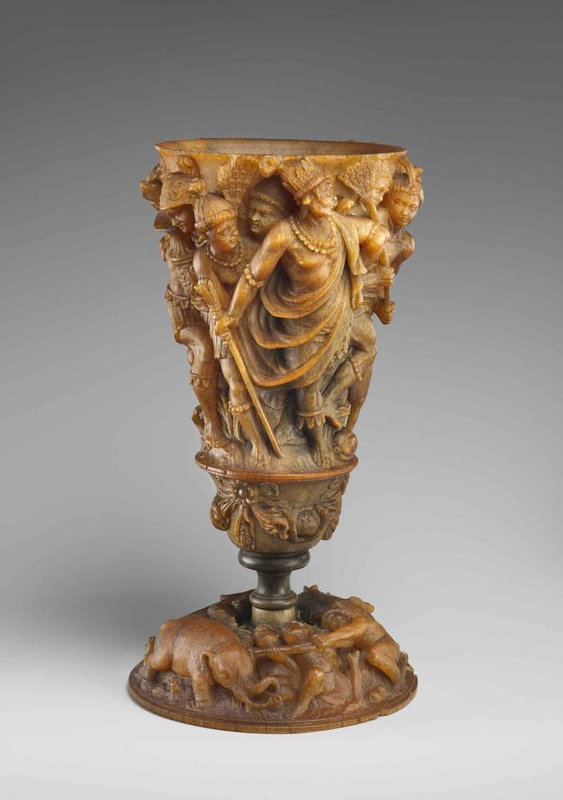
Southern German, possibly by Georg Pfründt (1603–63), Carved Cup, Second half of 17th century. Rhinoceros horn. H. 8 3/4 in. (22.2 cm); diam. 4 13/16 in. (12.2 cm). The Frick Collection, Gift of Alexis Gregory, 2021
Photo Joseph Coscia Jr.
Carved cups made from exotic materials were highly sought after during the sixteenth and seventeenth centuries. At the time of this cup’s making, rhinoceros and “unicorn” horns—likely narwhal tusks—were believed to be antidotes to poison. This cup depicts a procession in which the main figure holds a staff and wears a tunic, crown, and necklaces. An attendant is fanning him, and several figures are holding or playing musical instruments, while others carry a dish and a ewer for what seems to be a banquet. The bottom part of the body of the cup is decorated with garlands of fruit, and the foot of the cup depicts several men hunting an elephant and a rhinoceros.

Probably South German, Seated Lion Pomander, ca. 1575. Gold, diamonds, rubies, and enamel, 2 13/16 × 1 1/4 × 1 7/8 in. (7.1 × 3.2 × 4.8 cm). The Frick Collection, Gift of Alexis Gregory, 2021. Photo Joseph Coscia Jr.
Cast in gold and made of six distinctive parts—body, tail, head, collar, crown, and heart—this seated lion has a pelt and a flowing mane richly mounted with cut and faceted diamonds and rubies. The head and collar are set with rubies, diamonds, and black enamel. The chasing creates the effect of fur. The lion clutches a gold heart with diamonds, which bears an Italian inscription that may be a line from a poem: Che.gire.ancor qu.i.s.oggi orna (Here the heart adorns itself today so as to keep beating). The head, which can be unscrewed, and the small holes located on the head—in the nostrils and the mouth—identify this work as a pomander, a small object meant to contain aromatic substances and protect against disease.
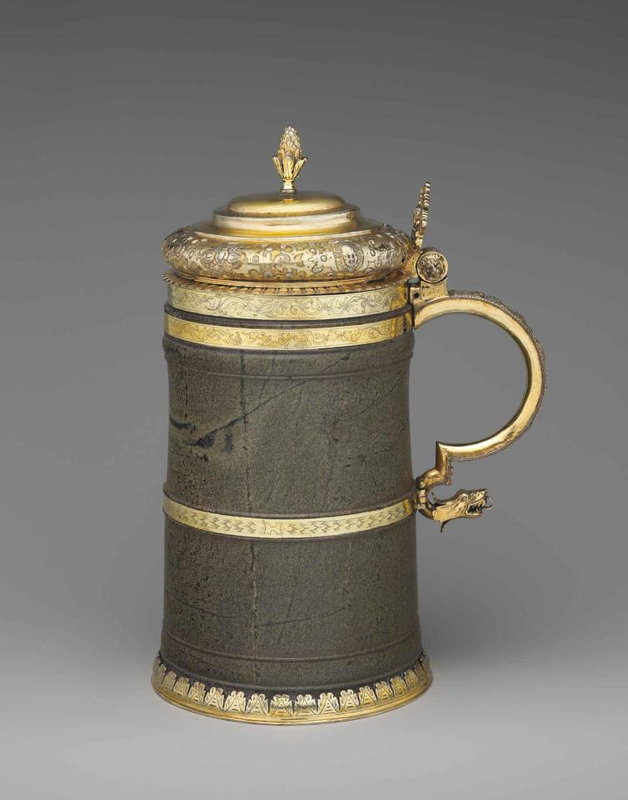
Saxon, Tankard, Late 16th or early 17th century. Serpentine and silver-gilt mounts, 11 7/8 × 8 13/16 × 6 1/8 in. (30.2 × 22.4 × 15.6 cm). Marks (on the lid): GH or CH. Gift of Alexis Gregory, 2021. Photo Joseph Coscia Jr.
A hardstone known since antiquity, serpentine was believed to protect against disease and neutralize poison. This large tankard has two thin rings toward the base. The band in the middle of the body is gilded like the rest of the mounts and decorated with motifs such as acanthus leaves. The lid is composed of two convex ornaments with a dart frieze and has repoussé scroll motifs and masks. The S-shaped handle has an animal head—perhaps a dragon—modeled in the round. The lid is decorated with a pinecone. Marks are visible in two places, but the goldsmith has not been identified.

European, Figure of a Blessing Christ. Possibly 17th or 19th century. Gold, enamel and diamonds, 4 11/16 × 2 3/16 × 1 5/8 in. (11.9 × 5.6 × 4.1 cm). The Frick Collection, Gift of Alexis Gregory, 2021. Photo Joseph Coscia Jr.
The Christ Child is shown with his right hand raised in blessing and gold flowers in his left hand. He wears a red gown, with a green and yellow collar and hem, and a gilt-silver necklace with diamonds. His face, hands, and feet are made of white opaque enamel, while his gown is made of red and green enamels. The nails are painted, and the eyes are rendered in blue enamel. The bouquet was probably enameled, as there are traces of color. The back of the figure is mostly flat, which suggests that it was positioned against a flat surface, perhaps in a niche where it was part of a larger ensemble.
The gilt bronze, which represents Louis XIV, is attributed to Domenico Cucci (ca. 1635–1704) and his workshop. Cucci was one of the most talented cabinetmakers of the eighteenth century, and this bronze is likely one of the few remaining remnants of a elaborate cabinet made for the king, around 1662–64. In 1883, the Musée du Louvre tried unsuccessfully to acquire the bronze, which mostly remained in private hands before being acquired by Gregory in 2007. Gilt bronzes and other objects designed by Cucci and produced in the Gobelins Manufactory (which made sumptuous furnishings and objects for French royal residences and as lavish diplomatic gifts) are mostly held in private hands. Besides the Frick, only a few collections, including the Château de Versailles, hold remnants of cabinets made by Cucci and his workshop.
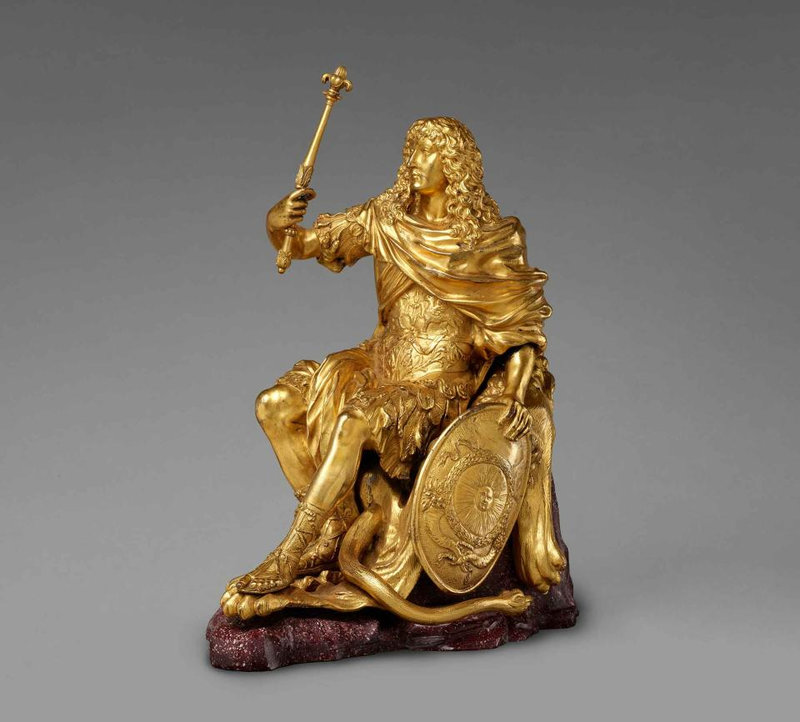
Attributed to Domenico Cucci (ca. 1635–1705) and Workshop, Figure of Louis XIV, Manufacture des Gobelins, Paris, 1662–64. Gilt bronze and porphyry, 13 5/8 × 11 15/16 × 7 1/16 in. (34.6 × 30.3 × 17.9 cm). The Frick Collection, Gift of Alexis Gregory, 2021. Photo Joseph Coscia Jr.
This sculpture, which may have been part of the so-called Cabinet of Apollo made after designs by Charles Le Brun, was among the first works of art produced at the Gobelins for Louis XIV of France (r. 1661–1715). The subjects depicted were intended to celebrate the king’s glory at the close of a lengthy war against Spain. Louis XIV is shown seated on a lion’s pelt—associated with Hercules—wearing armor, and draped in a cloak. He holds a scepter and an Apollo shield, one of his emblems. The upper part of the shield has been partially erased. The lion’s pelt, porphyry rock, and scepter are later additions.
Two clocks, one made by the British jeweler and goldsmith James Cox (ca. 1723–1800) and the second by Johann Heinrich Köhler (1669–1736), jeweler at the court of Dresden, diversify the Frick’s holdings of important clocks and watches and are key examples of their respective types. Both jewelers worked for powerful patrons: Köhler for Augustus II (“the Strong”), Elector of Saxonyand King of Poland , and Cox for the Chinese Qianlong Emperor. Cox crafted automatons with musical movements, also called “sing-songs,” which were exported to China, India, Persia, and Russia. Examples of their work are still on view in the Grünes Gewölbe (Green Vault) in Dresden and the Forbidden City in Beijing.

Attributed to Johann Heinrich Köhler (1669–1736), Parade Clock with Cameos, Dresden, ca. 1700–1710. Case: gilt bronze, cameos, emeralds, rubies, diamonds, heliotrope, and marble, 9 1/2 × 6 3/16 × 3 3/4 in. (24.1 × 15.7 × 9.5 cm). Mechanism signed Johan David Geyger Dresden. The Frick Collection, Gift of Alexis Gregory, 2021. Photo Joseph Coscia Jr.
This clock is decorated with twenty-six cameos and several gemstones. The outer edge of the dial is encrusted with diamonds and rubies. The cameos depict classical female and male figures and several heads of putti. A bust placed on a gilt-brass socle serves as the finial for the giltbronze case, which is also engraved with several motifs: a putto, portrait medallions, rinceaux, acanthus leaves, and architectural elements. The ornamental details with gemstones and cameos are similar to those of the Triumphal Arch with Two Obelisks (now in the Staatliche Kunstsammlungen Dresden) made by Köhler before 1705.
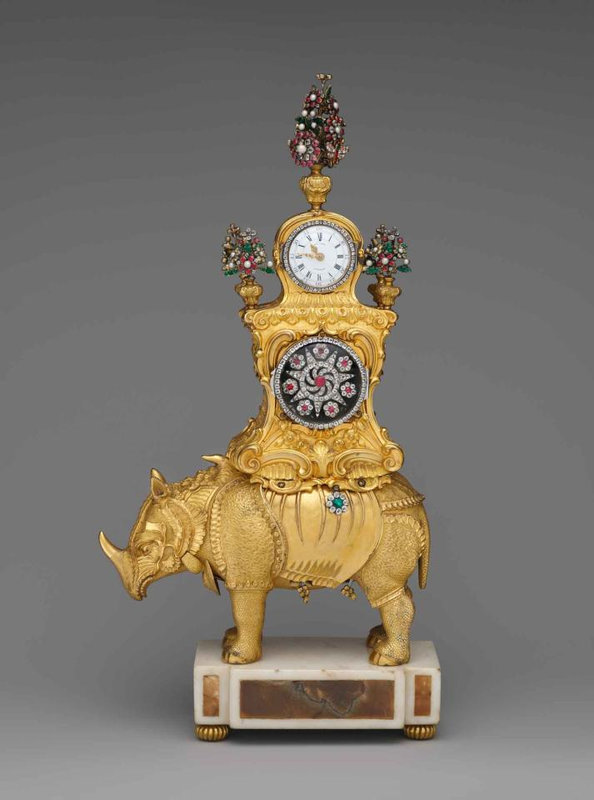
James Cox (ca. 1723–1800), Musical Automaton: Rhinoceros Clock, ca. 1765–72. Gilt bronze, silver, enamel, pearls, and colored glass. Pedestal: white marble and agate, 15 9/16 × 8 3/8 × 3 1/2 in. (39.5 × 21.3 × 8.9 cm). Two enamel dials, one signed JAs Cox London. The Frick Collection, Gift of Alexis Gregory, 2021. Photo Joseph Coscia Jr.
The “rhinoceros mania” began in Europe when a rhinoceros from India named Miss Clara was brought by the Dutch East India Company to Rotterdam in 1741 and exhibited in several cities until her death in London in 1758. Standing on a white marble pedestal and carrying a musical clock on its back, this rhinoceros figure is modeled after a celebrated print by Albrecht Dürer (1471–1528). The animal supports a small edifice that includes a clock and jeweled flowers. The chime mechanism, concealed on the back of the rhinoceros, strikes every half hour and can play two different tunes. The clock and its pendant may have been part of a more complex automaton that is described in Cox’s catalogue in 1774.
Gregory’s bequest also brings to the Frick several works by women. Opportunities were rare for female artists in Europe, and the work created by women artists is much sought after in today’s market. An enameled medallion, at right, by Suzanne de Court (act. ca. 1600), the only known female artist to lead a Limoges workshop during the sixteenth century, joins a notable pair of saltcellars signed by de Court already in the Frick’s collection. Two portraits by the celebrated Venetian pastel artist Rosalba Carriera (1673–1757), significantly enhance the museum’s holdings in this medium.
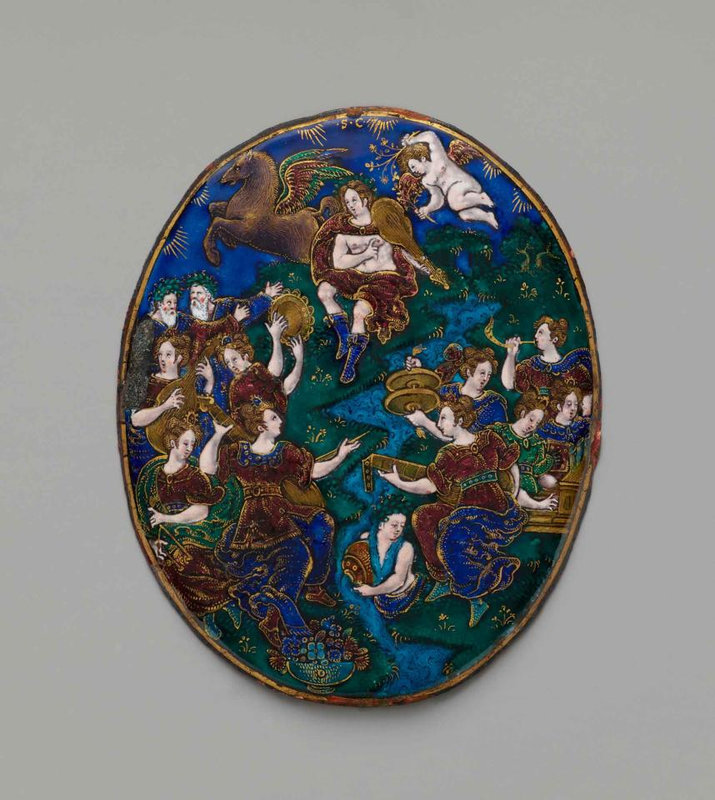
Suzanne de Court (act. ca. 1600), Oval Medallion: Apollo and the Muses, Limoges, ca. 1600. Enamel on copper, parcel-gilt, 4 1/4 × 3 1/2 in. (10.8 × 8.9 cm). Marks (at top of plaque): S.C. The Frick Collection, Gift of Alexis Gregory, 2021. Photo Joseph Coscia Jr.
This composition representing Apollo and the Muses on Mount Helicon derives from a print by Giorgio Ghisi (1520–1582) that was made after a drawing by Luca Penni (1500 or 1504–1557). Flanked by a putto and Pegasus, Apollo is playing his lyre on deep green grass. Two bearded men wearing laurel wreaths, perhaps poets, are gesturing in his direction. Seated at their feet are the Muses: Erato, the Muse of lyric poetry; Calliope, of epic poetry; Thalia, of comedy and pastoral poetry; Urania, of astronomy; Terpsichore, of dance; Melpomene, of tragedy; Euterpe, of music; Clio, of history; and Polyhymnia, of sacred poetry. The group is separated by a river into which the nymph Castalia pours water from a vase.
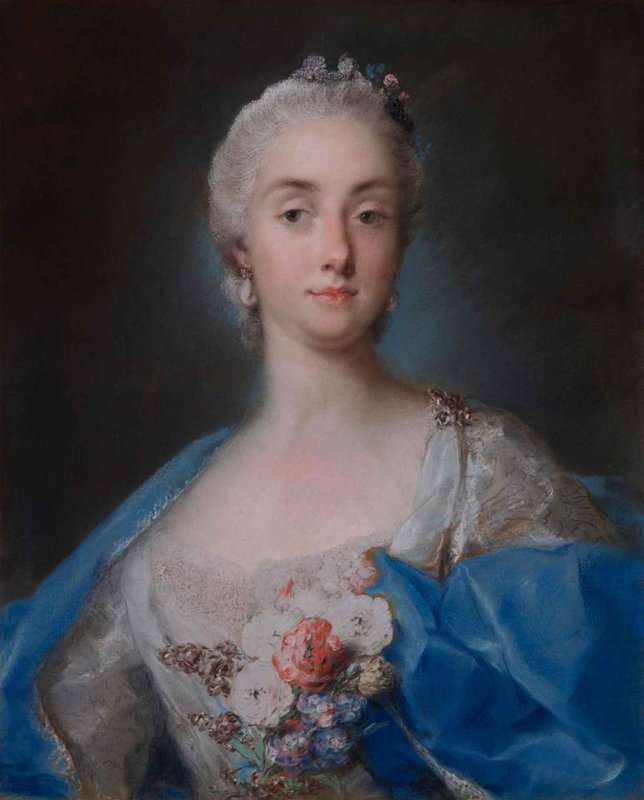
Rosalba Carriera (1673–1757), Portrait of a Woman, ca. 1730–40. Pastel on paper, laid down on canvas, 23 1/4 × 18 3/4 in. (59.1 × 47.6 cm). The Frick Collection, Gift of Alexis Gregory, 2020. Photo Joseph Coscia Jr.
The preeminent artist producing pastel portraits in eighteenth-century Venice, Rosalba Carriera became so celebrated that she was known across the western world simply as “Rosalba”—a remarkable development for a woman at that time. Patrons from throughout Europe— primarily Great Britain, France, and Germany—flocked to her house and studio on the Grand Canal to be portrayed by her. The unidentified sitter in this portrait is richly dressed and wearing lavish jewelry. Rosalba followed a series of prototypes when representing her sitters, and this pastel is a characteristic work by her.

Rosalba Carriera (1673–1757),Portrait of a Man in Pilgrim's Costume, ca. 1730–40. Pastel on paper, laid down on canvas, 23 1/4 × 18 7/8 in. (59.1 × 47.9 cm). The Frick Collection, Gift of Alexis Gregory, 2020. Photo Joseph Coscia Jr.
The black cape the sitter wears and the baton he holds are typical attributes of a pilgrim. It is not known who the sitter is, but these attributes could be a reference to his surname— Pellegrini (Italian), Pilgrim (English), Pèlerin (French), Pilger (German). It is more likely, however, that these elements, together with the sitter’s casually placed tricorn hat, represent a costume for the Venetian Carnival. In 1720–21, Rosalba traveled to Paris, where she became acquainted with Antoine Watteau (1684–1721). In a number of paintings, Watteau depicts aristocrats in pilgrim attire journeying to the mythological island of love. It is possible that this portrait was commissioned by a nobleman familiar with Watteau’s art and desirous of an allusion to it.

/https%3A%2F%2Fprofilepics.canalblog.com%2Fprofilepics%2F1%2F0%2F100183.jpg)
/https%3A%2F%2Fstorage.canalblog.com%2F03%2F02%2F119589%2F96711876_o.jpg)
/https%3A%2F%2Fstorage.canalblog.com%2F11%2F31%2F119589%2F94773502_o.jpg)
/https%3A%2F%2Fstorage.canalblog.com%2F20%2F83%2F119589%2F94772815_o.jpg)
/https%3A%2F%2Fstorage.canalblog.com%2F26%2F72%2F119589%2F75604929_o.jpg)
/https%3A%2F%2Fstorage.canalblog.com%2F59%2F60%2F119589%2F26458628_o.jpg)





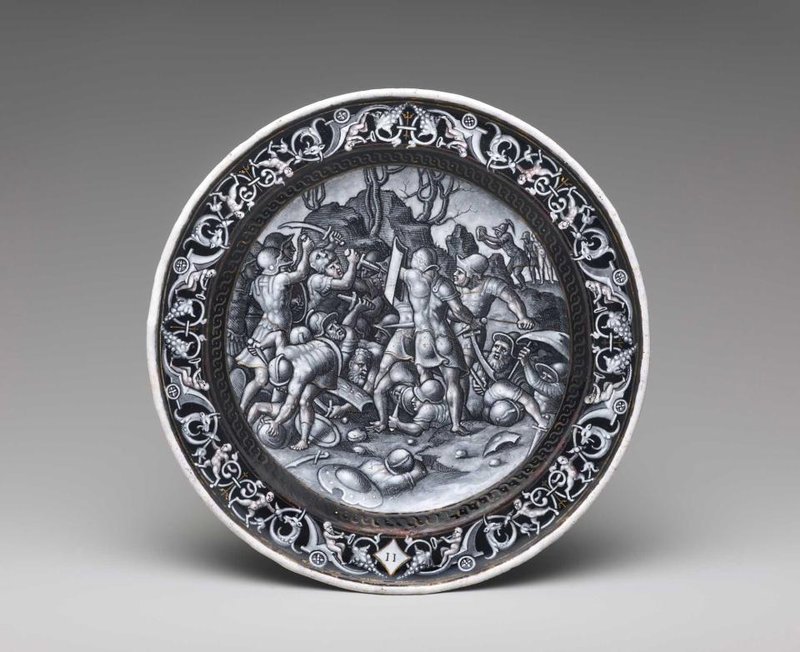

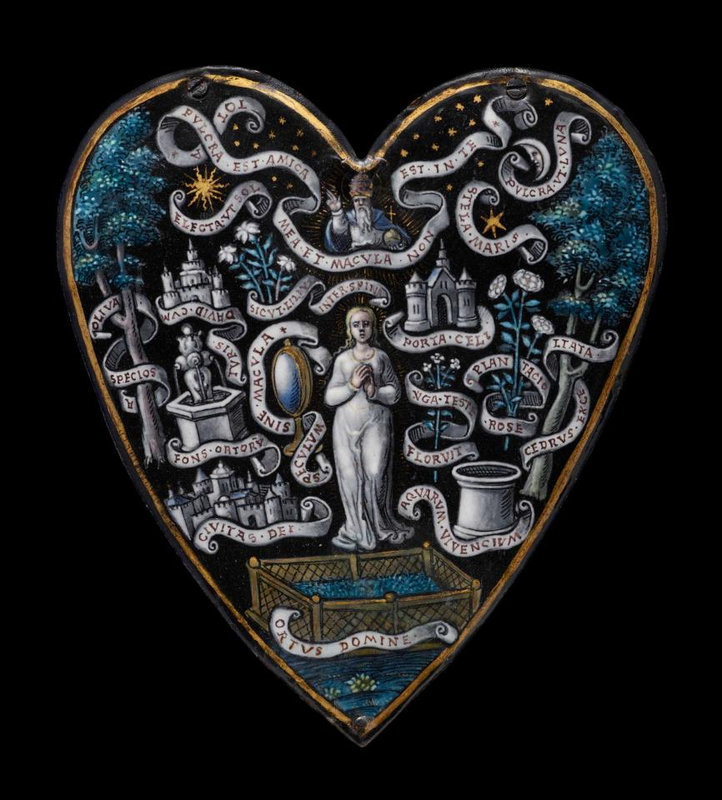
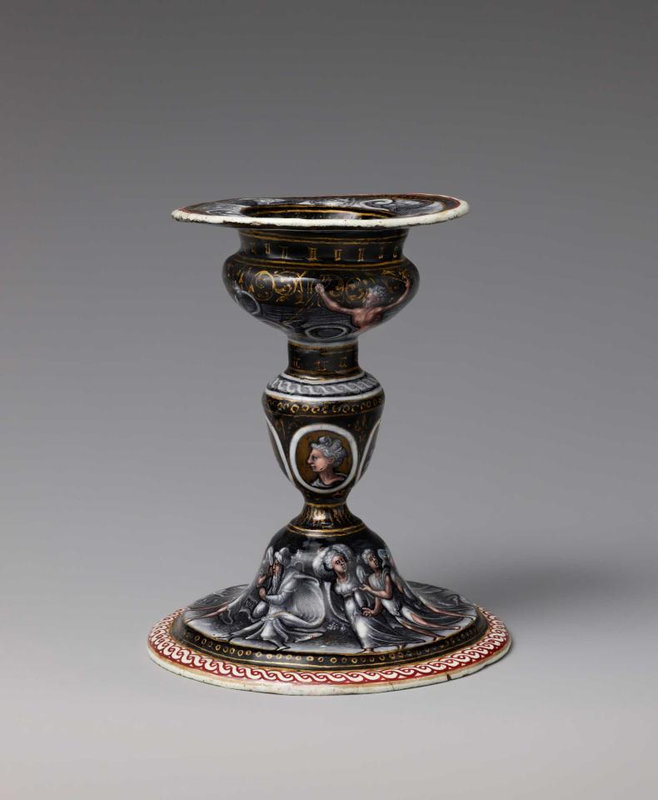



/http%3A%2F%2Fstorage.canalblog.com%2F50%2F81%2F119589%2F121359672_o.jpg)
/http%3A%2F%2Fstorage.canalblog.com%2F74%2F70%2F119589%2F111709125_o.jpg)
/http%3A%2F%2Fstorage.canalblog.com%2F05%2F46%2F119589%2F110103929_o.jpg)
/http%3A%2F%2Fstorage.canalblog.com%2F33%2F95%2F119589%2F110103720_o.jpg)